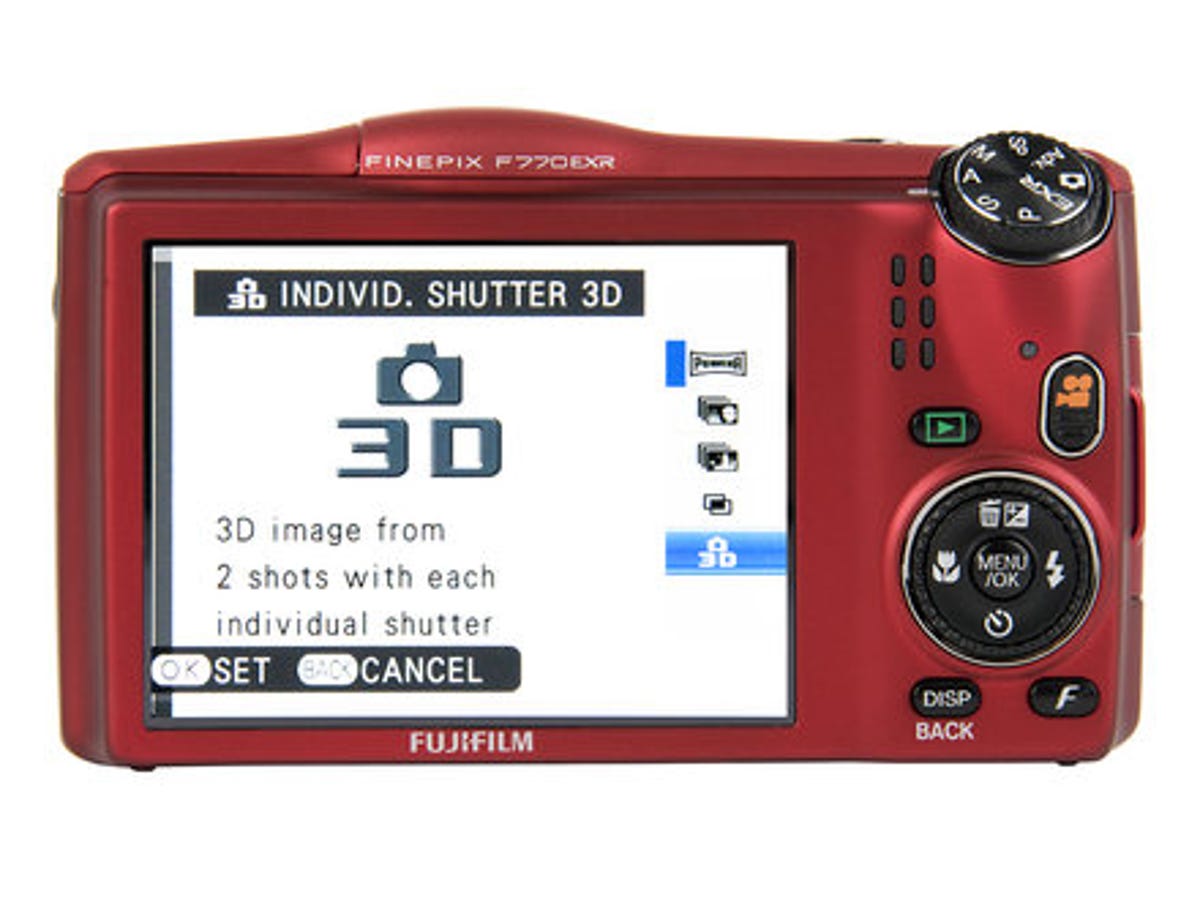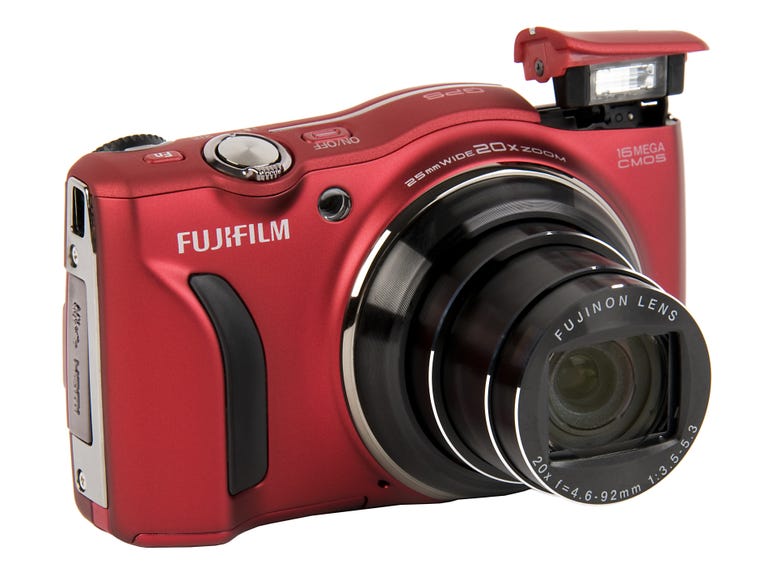 Why You Can Trust CNET
Why You Can Trust CNET Fujifilm FinePix F770EXR review: Fujifilm FinePix F770EXR
The Fujifilm FinePix F770EXR is an impressive all-round compact camera with a long zoom, high resolution and built-in GPS.
Its high resolution, 20x zoom and built-in GPS may be the headline features, but where the Fujifilm FinePix F770EXR really excels is the quality of its images.
The Good
The Bad
The Bottom Line
This compact camera is the latest in Fujifilm's line-up to use the company's EXR sensor. With this, the pixels are rotated by 45 degrees to make better use of the available light, so you get better dynamic range in your shots.
You can pick up the Fujifilm FinePix F770EXR now for around £240.
Specs and features
The finish is simply lovely, with a swooping chassis to house the GPS receiver, a chunky hand-grip and rubberised casing, which makes it feel good and helps you keep a firm hold.

It's not just a pretty face. Under the hood, the specs are impressive. Sensitivity extends to ISO 12,800, so long as you're happy to see your images trimmed to accommodate it. Keep it at ISO 3,200 or below though, and you can make use of every photosite on the 16-megapixel chip to produce 4,608x3,456-pixel shots.
In front of this is a 20x zoom, equivalent to 25-500mm on a regular 35mm camera, with a maximum aperture of between f/3.5 and f/5.3, depending on magnification. This full telephoto metric is particularly impressive when you consider the length of the lens.
Minimum focusing distance at wide angle is a slightly podgy 45cm, and at telephoto it tops out at 2.5m. Switch to macro mode and you can come in as close as 5cm. If you prefer to stand back and zoom while in this mode, to avoid casting shadows on your subject -- a risk you run if shooting outdoors in direct sunlight or indoors under studio lighting -- you can work from as close as 1.3m in full telephoto.
It uses the same excellent menus that Fujifilm has rolled out across the rest of its range. Any options that aren't applicable to your current shooting mode are greyed out but left in place so you'll get used to seeing a familiar line-up. The modes themselves are selected using an angled wheel on the top of the body and include the excellent EXR mode. It makes use of the sensor's unique pixel arrangement to let you prioritise high sensitivity with low noise, high dynamic range or maintain the highest possible resolution for your particular shooting conditions.
Changes to shutter speed and aperture are made using a fast thumbwheel on the back of the body. But while you can set the shutter at a range of common speeds between one second and 1/2,000 second, you can only select from three aperture settings at any zoom level. At wide angle, these are f/3.5, f/7.1 and f/10. At maximum telephoto they're f/5.3, f/11 and f/16, with the position of the lens in-between affecting the aperture in the same way as it would on any other camera.
Stills tests
I performed my tests using a mixture of aperture priority, fully automatic and the EXR modes. I also used the panorama scene mode, with all images saved as default JPEGs, without any processing applied.
The panorama mode makes an excellent job of stitching together up to 360-degree sweeps of your surroundings. The results couldn't be faulted when shooting a conventional side-to-side panorama with the camera in landscape orientation. However, when switching to vertical panorama mode to capture a taller sweep of the scenery, using the camera in portrait orientation, it occasionally introduced vertical dark and light stripes under overcast skies. These appeared to be points at which the camera had stitched together thin slices of the scene.
Regular stills didn't exhibit these stripes and neither did regular landscape panoramas. I found that switching to EXR for stills would often improve things still further. I did my testing in Glen Coe and was often shooting in overcast or misty conditions, so switching from fully automatic to EXR helped enormously in boosting colours to produce a more punchy set of realistic shots.
Macro mode produced consistently crisp images, with fine detail rendered very clearly -- see the spider in the image below, for example. An attractive shallow depth of field draws the eye to the focal point within the frame.
It was very quick to find focus, even in poor light. Although there was some fall-off in the level of focus when comparing the centre of the frame with the image captured in the edges and corners, it wasn't particularly pronounced. It shouldn't present a problem if you're cropping away from the centre of the frame to rebalance your composition in post-production. Since the lens in a compact camera is bending the light to a more extreme degree, this is to be expected.
Low-light performance was good, with accurate colours at ISO 1,000 and light, fairly even grain evident in my test shots. Pushing sensitivity up to ISO 3,200 by increasing the shutter speed naturally introduced more noise to the image. This impacted on the level of detail, but this was not enough to prevent it from accurately capturing the slats of a blind reflected in a mirror, the ribbing on the frame of the mirror or the texture of the sheepskin rug. Colours remained true and there was no undue colour noise, whereby the sensor introduces tones that aren't present in the original setting.
Video test
The F770EXR shoots HD video at 1,920x1,080 pixels or 1,280x720, 30 frames per second, or 640x480, again at 30fps. The results are good, with sharp pictures and no trouble handling fast-moving subjects as they move across the frame and towards the lens.
The audio track is a particular highlight, with a clean, clear recording picking up even faint sounds.
The optical zoom is a problem though. It's noisy in use and spoils that crisp soundtrack if you zoom while filming -- it can be heard very clearly shuffling the lens barrel. Furthermore, the F770EXR has some trouble maintaining focus during the zoom operation, although it does recover quickly once you let it rest in its new position.
Conclusion
I've consistently been impressed by the performance of Fujifilm's EXR sensor system and this camera lives up to my high expectations.
The camera's build quality is great and stills output is excellent, thanks to a sharp lens, high resolution and a great set of options. The movie mode performs well too, so long as you're not going to rely on the zoom too often. All in all, it makes for a very rounded package.
The £250 price is very fair for what you're getting here. The range of features and the advanced specs ensure it won't feel out of date any time soon. Beginners who start out shooting in full auto mode will find plenty of opportunities to learn more and refine their skills by exploring what else it has to offer.


